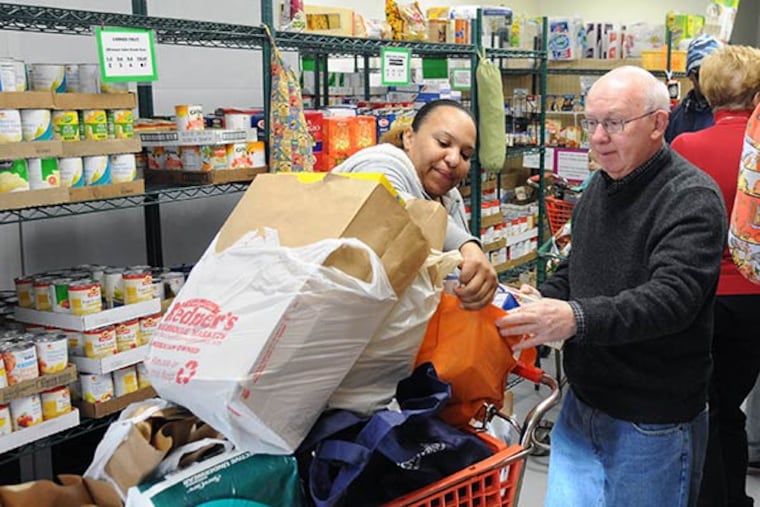Most voters in both parties support increasing food stamps for those in poverty, poll finds
The poll also discovered that “only the wealthiest and most conservative Americans support cuts” to food stamps and other safety-net programs.

As the holiday season begins, low-income Americans are receiving a rare bit of good news: Five times more voters from both parties would increase federal funding for food stamps than those who would cut it.
That finding comes at a time when the Trump administration has announced its third plan to reduce food stamps, now called SNAP for the Supplemental Nutrition Assistance Program.
The poll of likely 2020 voters nationwide was commissioned by Hunger Free America, a national nonprofit headquartered in New York.
According to the survey of 1,000 people, 58% want SNAP funding increased, with 32% of that group saying the money should be boosted significantly.
By comparison, 24% of likely voters want funding kept at current levels, while just 11% advocated cuts; 7% had no opinion.
Further, support for the program was “very strong” among likely voters of both parties in swing states, the poll showed.
SNAP is currently funded at about $68 billion a year, and serves around 39 million people, according to the U.S. Department of Agriculture, which administers the program.
As of October, 1,752,648 Pennsylvanians were receiving SNAP benefits; in Philadelphia, the number was 456,217, figures from the Greater Philadelphia Coalition Against Hunger show.
“The poll explodes the myth that Americans of any persuasion are clamoring to take food assistance away from hungry children, working people, seniors, veterans, people with disabilities, and those temporarily unemployed,” said Joel Berg, CEO of Hunger Free America.
“On the contrary, we found that Americans agreed that domestic food aid is underfunded.”
The poll also discovered that “only the wealthiest and most conservative Americans support cuts” to SNAP and other safety-net programs, according to Benjamin Kupersmit, lead researcher for the survey.
Administration still cutting SNAP
Members of the Trump administration can be counted among those in favor of slashing SNAP.
The poll, then, uncovers a disconnect between the will of Americans and the desires of the president.
Agriculture Secretary Sonny Perdue has said that some Americans abuse the SNAP program, creating waste.
“The American people expect their government to be fair, efficient, and to have integrity — just as they do in their own homes, businesses, and communities," he said in a statement.
Hunger-fighting organizations such as the coalition have long disputed conservative claims of waste, fraud, and abuse in SNAP, pointing out that the program is among the least fraud-ridden federal initiatives.
Last month, the USDA said it wanted to remove $4.5 billion from SNAP over five years.
If the proposed change goes through, about half the households in Pennsylvania would lose $40 a month in SNAP benefits, according to Kathy Fisher, the Coalition’s policy director. The average Pennsylvania household benefit is around $219 a month, she said.
“People are shocked and angry” at the proposed cut, Fisher said, adding that she believes the Trump administration is using the cover of the impeachment crisis to shrink SNAP.
“The administration is trying to carry out really damaging changes that are unfair to poor people.”
Kicking people off SNAP
Prior to the October proposal to slash SNAP, the USDA proposed a rule change in July that would kick an additional three million people off the program, including 200,000 Pennsylvanians and 250,000 New Jerseyans.
In March, the agency sought to place more stringent work requirements on SNAP recipients.
None of the suggested cuts has been finalized.
Last year, President Donald Trump himself recommended sending boxes of food instead of SNAP benefits to people, an idea decried as impractical and likely more expensive than the SNAP program itself.
If, however, the three proposed changes were to be implemented, an estimated 3.7 million fewer Americans would receive SNAP in an average month, with annual benefits decreasing by $4.2 billion, according to an analysis by Laura Wheaton, senior fellow at the Urban Institute, an economic and social policy think tank in Washington.
Congress and the people agree
Versions of the proposed SNAP trims were brought up and rejected in Congress last year when the Farm Bill, which pays for SNAP, was passed.
Now, the Hunger Free America poll shows that average Americans seem to side with Congress in rejecting the notion of reducing SNAP money.
“Congress specifically did not want these cuts, but the White House is nevertheless moving forward, even though both Congress and the public don’t seem to want them,” said Kate Scully, director of government affairs for Philabundance, the region’s largest anti-hunger agency.
“The public understands that we can’t have people going hungry. Unfortunately, if you cut a program like SNAP, you’re taking food off people’s tables.”
While one in six Americans struggles with hunger, the situation is worse in Philadelphia, the nation’s poorest big city, where one in five residents don’t have enough to eat, Fisher said.
“During the holiday season, people think more about the poor,” Fisher said. “Our culture celebrates the holidays a lot around family meals.
"It makes people consider those who can’t afford to do that now, and all year round.”